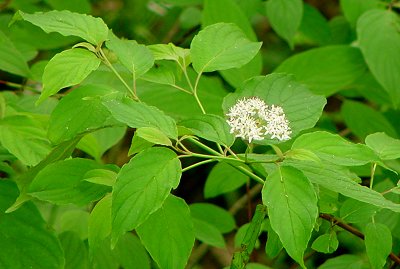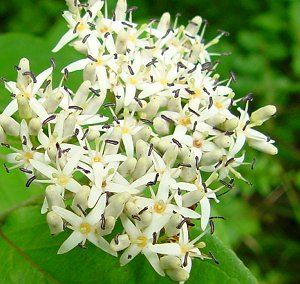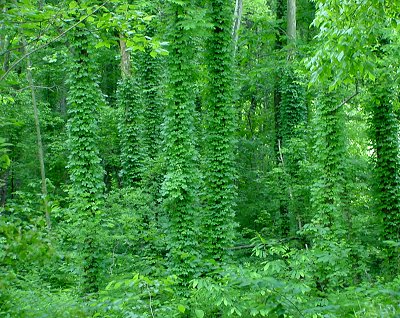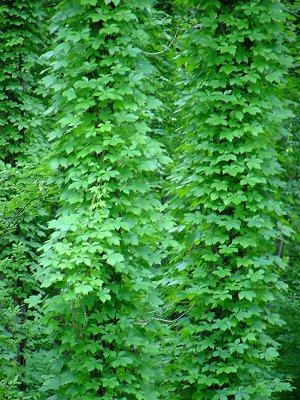
I believe that this is one of the Viburnums, probably Viburnum prunifolium a.k.a. Blackhaw. (The blooms are from a couple of weeks ago.)
Edited to add: So, not a Viburnum! I'm a rank tree-identification amateur and got it wrong. Thanks so much to the Ontario Wanderer who pointed out that this is actually a type of Dogwood. (I'm thinking it's a Silky Dogwood (Cornus amomum), but the ID requires more examination of the tree than I have time for this morning so will have to look over the weekend.
Edited for a second time to add: My husband had to call to tell me, "I told you that was a dogwood!" Now that I think about it, he did. I just wasn't paying attention to him. (He would say, "as usual".)

The flowers up close.

Virginia Creeper (Parthenocissus quinquefolia) tries to take over the world.

Often mistaken for Poison Ivy (which has three leaves instead of five).
Some tree links:
Trees of Alabama and the Southeast
100 Trees of Alabama
Some southeastern U.S. trees and woody plants
(Takes a while to load even with zippy DSL. They have other regions too.)
Key to the Gymnosperms of the Southeastern U.S.


15 comments:
Do those Creepers eventually kill the tree, or are they harmless? they sure are pretty. Do they turn colors in the fall?
Apparently they can strangle the tree, but I'm not sure if it always happens or not. They do turn in the fall - click the link and you can see the color.
I always loved the name Virginia Creeper. You get Kudzu too, I bet.
Kudzu, a.k.a. the vine that ate the south...
Lots of Kudzu in the area but none on our land so far, thankfully.
Didn't I read somewhere that Kudzu may be used to treat alcoholism?? Or was it some other disorder...
I tried drinking kudzu once. I went back to beer.
We have Virginia creeper around here, too. It likes to co-exist with the poison ivy. It's a beautiful vine, though. And there's a beautiful sphinx moth whose larvae are Viginia creeper specific in their tastes.
Anyways, those photos redefine the term "verdant". Holy mackerel that's a whole lots of green.
Swampy, hadn't heard that. Some people eat parts of it (the roots and blossoms mostly I think) and make baskets from the vines.
Brian you are as good as Happy & Blue 2 and Rainypete. Are you sure you're not Canadian? :) But yeah the overall green-ness is what made me take the picture in the first place.
As usual your pictures are wonderful! Have you named all of the kitties yet?
I think your "viburnum" is a dogwood. Viburnums have flowers with 5 petals. Dogwoods have 4 petals. What colour are the twigs? What colour is the pith inside the young twigs?
P.S. I am attempting to start a blog of my own in addition to my web site. Any suggestions?
http://ontariowanderer.blogspot.com/
Doesn't anyone else feel like saying "Jeepers, where'd you get those creepers"?
Dean, that's you, yeah?
Very nice blog! You need a link to your web site on there though.
Thanks so much for the tree ID help. I'm such a rank amateur when it comes to trees!
I looked at some pics on the USDA plants database and it appears like it might be the Silky Dogwood (Cornus amomum).
I'll have to wait to look at the twigs & pith to be sure though, since it's a boots-on excursion and I'm short on time today!
Jerry I bow down to you as a clearly superior punster! :)
Rho, the two little ones are Dusty and Ginger. The tiger cat I've been calling Alley Cat, but may change it...
Ali Khat?
Kudzu -- kuzu -- roots can be dried and ground into a powder that functions in cooking rather like arrowroot, and that's what the Japanese do with it. More ~refined~ than cornstarch. The leaves are supposed to be good cattle fodder, I think.
I have no idea what kind od preparation is supposed to be useful against alcoholism. I have cartoon dreams of chaingangs of drunk-driving convicts being driven to browse through the woods. oddly muffled work songs and field hollers, sung with their mouths full... "Gon' mgmff dat nrghfh..."
Ron, LOL! You should be writing screenplays. Also - Ali Khat... I like it!
Here's a link to a study about the use of Kudzu for treatment of alcohol.
Here's a link to a CBC story about the same. Apparently it makes people feel drunk on less alcohol. Sort of a strange way to combat alcoholism but if it works I guess livers everywhere would be happier.
Here's the cheap and easy way to recognize dogwoods. First, they have opposite leaves, and not a whole lot of trees and shrubs do. The species that have opposite leaves can be remembered with the acronym MAD Horse: Maples, Ashes, Dogwoods, and Horsechestnut.
And if you take a leaf of any dogwood and tear it slowly, the leaf veins will stretch out between the pieces in individual strands, like hot cheese. Only dogwoods do this. (This is a crappy description! But try it and see.)
Post a Comment